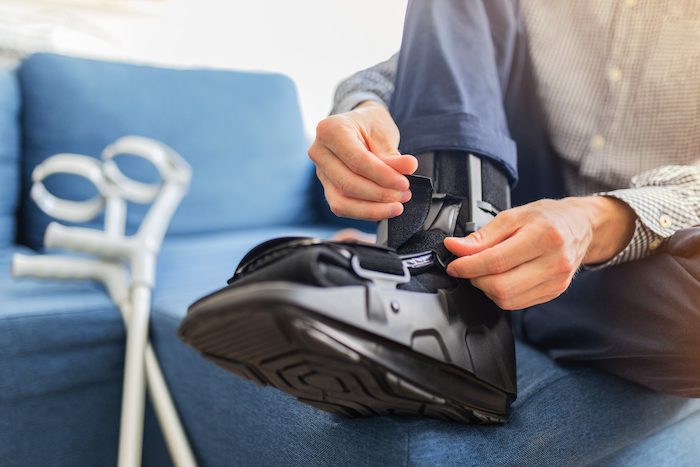When Can I Drive After a Broken Metatarsal, Foot or Ribs?

Some injuries might affect your abilities to drive.
In this post we’ll explore whether it’s safe to drive after certain injuries – from a medical perspective, a legal perspective, and a car insurance perspective.
Is it Legal to Drive with a Broken Foot?
You must tell the DVLA if you’ll be unable to drive for more than three months after any broken bone.
Fill in this form to tell the DVLA about a broken bone that’ll affect your driving.
If you don’t tell the DVLA about a medical condition that affects your driving you could be fined. And, if you are involved in an accident as a result of driving with an undisclosed medical condition, you could be prosecuted and your car insurance claim could be invalidated.
When Can I Drive After a Broken Metatarsal, or a Broken Foot?
Depending on your injury, doctors might put your affected area in a cast, or they might give you a special boot to wear to support your foot. You might have to wear this boot for up to six weeks. And doctors will agree that you shouldn’t drive a car for as long as your foot’s in a boot or a cast.
No matter what bone you break in your foot – whether it’s a toe or one of your metatarsal bones – the symptoms are likely to be the same: pain, swelling, bruising, and an inability to bear weight on your foot. All of these will make it difficult, if not impossible, to drive.
Even after you’ve stopped wearing your boot or cast, you may still experience some symptoms, including stiffness, swelling, and decreased strength. These symptoms may still make it difficult for you to drive.
Talk to your doctor for specific advice about your condition.
Some doctors might say you’re OK to drive so long as the break’s in your left foot, and you drive an automatic car. But even then, you might have to take some strong painkillers through your recovery, which might come with certain side effects that will affect your ability to drive. Once more, talk to your doctor for more information.
And remember to tell the DVLA if they think you’ll be unable to drive for three months or more.
When Can I Drive After Broken Ribs?
You should talk to your doctor for specific advice. Depending on your injury, it could take between six and 10 weeks for your ribs to heal, and they might advise you to avoid driving entirely for the duration of this period.
Bruised or broken ribs might not affect your mobility in quite the same way as a broken limb would. But they can be exceptionally painful, and they can make it difficult to breathe. As such, many people struggle to do almost anything while they’re waiting for broken ribs to heal.
You might find it too painful to drive with bruised or broken ribs, or a broken sternum. Any time you move your arms you’ll also move your ribcage, so constantly moving the wheel or changing gears might be difficult. And if you have to make a sudden movement, such as a swerve to avoid an obstacle in the road or an emergency stop, it could cause an unbearable amount of pain.
Your doctor might prescribe you with painkillers to help you through the healing process. But even with these you should avoid driving, as certain painkillers can make you drowsy.
When Can I Drive After Breaking an Arm, a Leg, or Collarbone?
There are no clear guidelines for how long you should wait to drive after breaking a bone. But as a general rule of thumb, you should never drive if you’re wearing a sling or a cast anywhere on your body. Nor should you drive while you’re wearing a collar to support your neck, as this will likely affect your ability to move your head to check your mirrors and blind spots.
How long until you can drive all depends on the severity of your injury and your course of treatment. Also, certain factors might affect how long it takes your bones to heal.
Once more, talk to your doctor for more advice. They’ll have a better idea of how long it’ll take for your injury to heal, and the sort of activities you should avoid in the meantime, such as driving.
But don’t be tempted to ignore your doctor’s orders. Remember, you can get a hefty fine, and potentially a prosecution, if the police catch you driving with a debilitating medical condition.
Do I Have to Tell My Insurers About a Broken Bone?
You have to tell your car insurance provider if anything changes during the term of your policy, and this includes medical conditions. You need to declare anything that might effect your motor skills, your cognitive abilities, and your range of movement. But most insurers will only require you to declare long-term or permanent conditions. Broken bones heal in time, and for the duration of the healing, you probably won’t be driving anyway.
Head here to read our full guide to the sort of medical conditions you need to declare to your insurers.
So it might not be necessary to tell your insurers about a broken bone, though your insurer will likely appreciate it if you let them know you’ll be off the road for a while.
However, if you decide to drive with a broken bone and you’re involved in an accident, you may find your claim is invalid – especially if they find you acted against your doctor’s orders. So as well as facing prosecution and a fine, you might also have to face significant repair bills. Driving with a broken bone really isn’t worth the risk!
For more information about our insurance and what it covers, see our insurance for young drivers.







